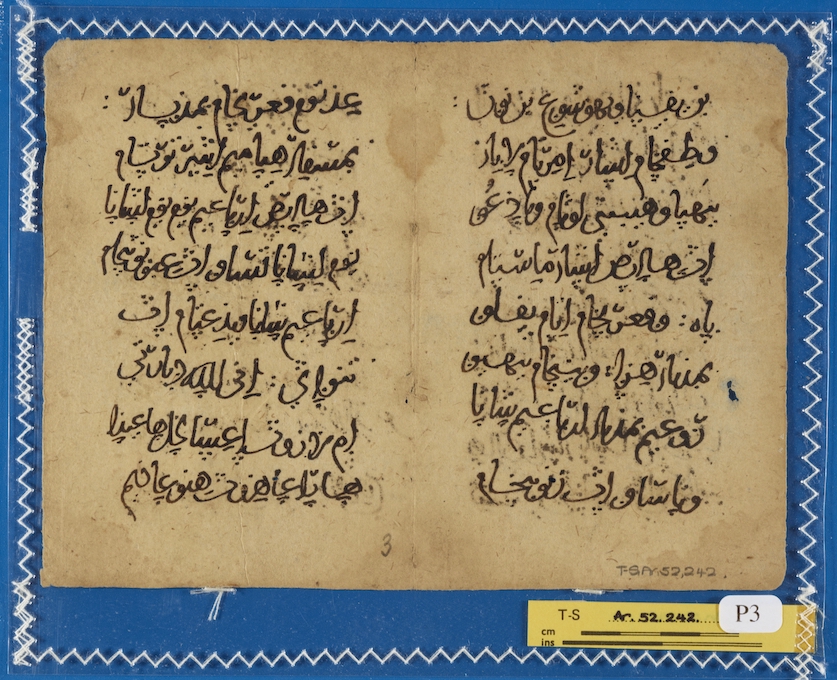Throwback Thursday: Uncovering the Karaites

Our Throwback Thursday this week is taken from issue 17 of the printed edition of Genizah Fragments, published in April 1989, by Geoffrey Khan while he was a Research Associate in the GRU:
Among the treasures of the Cairo Genizah collections are a number of Hebrew Bible manuscripts written in the Middle Ages by members of the Karaite Jewish sect. These manuscripts are unusual in that the text is written not in Hebrew, but in Arabic script, sometimes with Hebrew pointing. The synagogue in which the Genizah was situated belonged to a Rabbanite community in Fustat; the presence of Karaite manuscripts in the Genizah is, therefore, somewhat unexpected.
Karaite literary sources are full of uncompromising hostility towards the Rabbanites. The Genizah documents record many conflicts between Rabbanites and Karaites in Palestine, where a large Karaite community existed. In Egypt, however, during the tenth to twelfth centuries, there appears to have been less tension between the two communities; intermarriage, for example, was quite common. Occasionally Rabbanites and Karaites even worshipped together. The Karaite manuscripts no doubt found their way into the Rabbanite Genizah due to these social and religious contacts.
The British Library contains a number of similar Karaite Bible manuscripts, acquired by the bookseller, M.W. Shapira, in Cairo towards the end of the last century. A comparison between these and fragments discovered in the Genizah indicates that the two groups come from the same scribal circles. In a few cases, fragments obtained by Shapira and sold to the British Library (together with manuscript codices) appear to originate from the same manuscript as fragments in the Genizah collections. Shapira must have had access to Genizah fragments and selected from them items which were related to the Karaite manuscripts which he had acquired elsewhere.
The main source of the extant Bible manuscripts in Arabic transcription was the Karaite community in Palestine. A colophon preserved at the end of one of the manuscript states that it was written in Ramlah in 395 A.H. (1004 - 1005 C.E.). Several features of Hebrew pronunciation reflected by the transcriptions correspond to those characteristic of mediaeval Palestine.
The manuscripts were taken to Cairo probably at the time of the invasion of the Crusaders at the end of the eleventh century. A few may even have been written in Cairo by Karaites who had fled from Palestine or had strong connections with the Palestinian Karaite community during its apogee in the eleventh century.
Karaite Bible manuscripts from the later Middle Ages are written in Hebrew script. The destruction of the Karaite centre in Palestine by the Crusaders gave a mortal blow to the tradition of transcribing the Biblical Hebrew text into Arabic script. The practice of the Karaites to transcribe Hebrew into Arabic letters was restricted almost exclusively to Biblical and liturgical texts. The Karaite liturgy consisted basically of a collection of Biblical verses. Hebrew texts composed by Karaites during this period, such as legal documents, colophons at the end of Bible manuscripts and works in poetic form, were all written in Hebrew script.
The motivation for the transcription of Hebrew lay in the Karaites' attitude to the written tradition of the Biblical text. Certain Karaite circles were anxious to continue the work of the Tiberian Masoretes and accurately to preserve the details of the Masoretic tradition. There were some Karaites, however, who expressed qualms about the accurate transmission of the written text of the Bible by Rabbanite scholars. They pointed out conflicts between the written text and the way it was read, as well as inconsistencies in orthography.
The view that the Rabbanites had corrupted the transmission of the text of Scripture corresponds to the concept of tahrif (textual corruption), a prominent motif of mediaeval Muslim polemic against the Jews and Christians, which is also found in Muslim Shi'ite writings against their Sunni co-religionists.
The transcription of the Hebrew Bible into Arabic letters was an attempt to represent the reading tradition in a direct and systematic manner and so overcome the discrepancies with the reading tradition which are found in the traditional written form of the Biblical text.

Add new comment